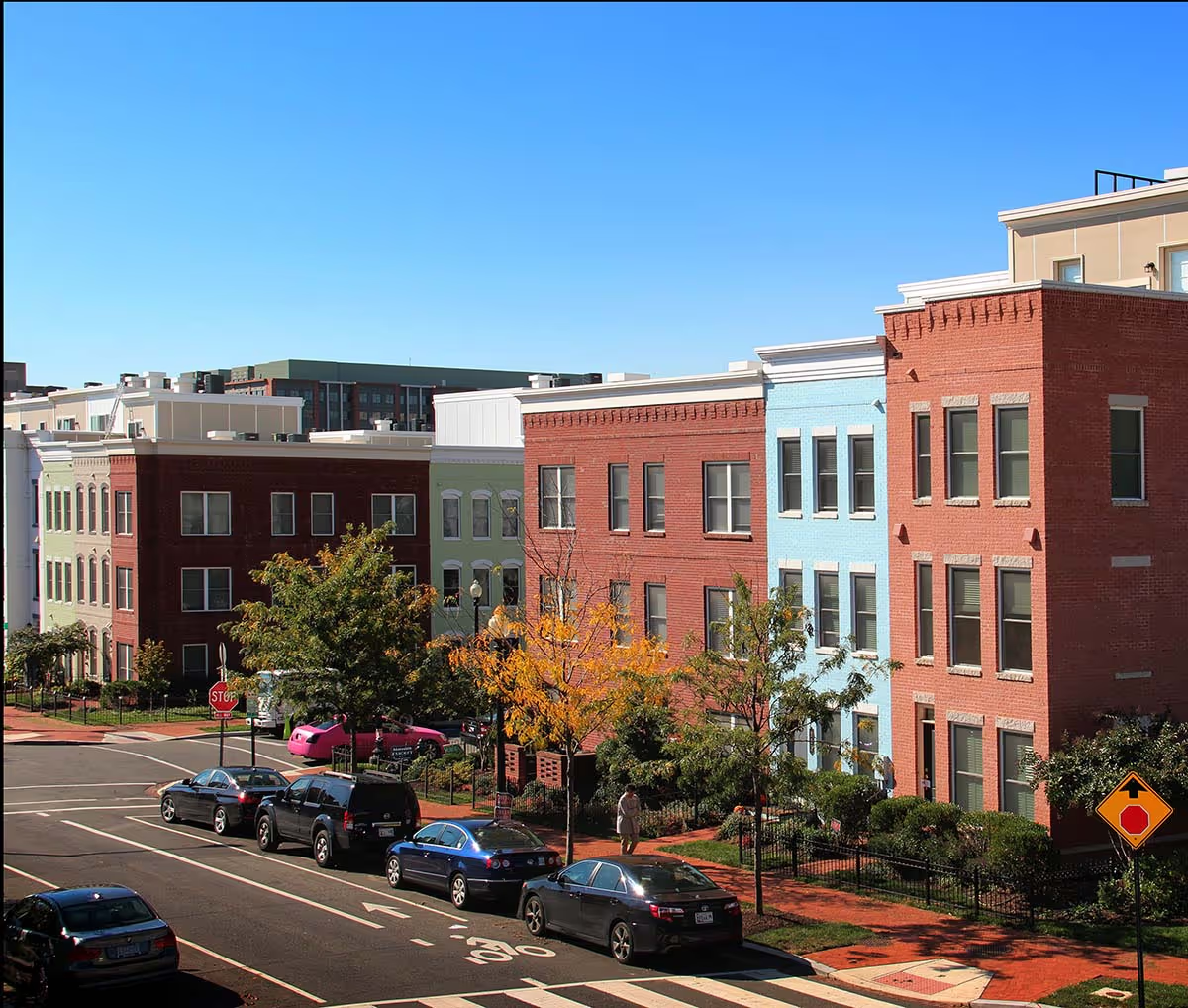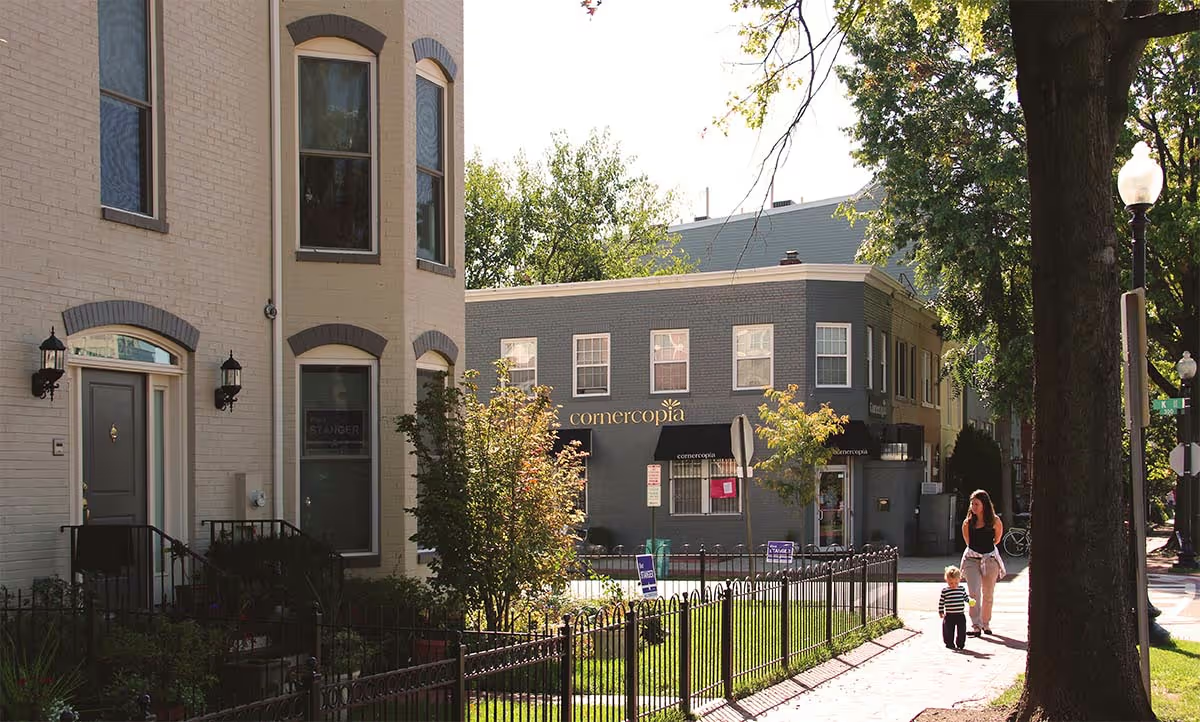
Arthur Capper / Carrollsburg
Challenge
Replace a disinvested public housing development by creating a revitalized, mixed-income/mixed-age/mixed-use neighborhood that better serves its residents and effectively extends the Capitol Hill neighborhood toward the Anacostia River.
Solution
Working through a collaborative public process, design and develop a sustainable, pedestrian-oriented neighborhood fully integrated with its surroundings, helping to catalyze the revitalization of the larger Anacostia riverfront area.
23 acres
1,562 total housing units
1,150 new rental and for-sale
412 new rental units off site
707 replacement Units
600,000 SF office space
75,000 SF retail space
17,000 SF LEED® Certified
community center
1 new park
32,000 new jobs in Capitol Riverfront
$1 Billion in total public investment in Capitol Riverfront that has leveraged over $2 Billion of private sector investment
Reimagining the Arthur Capper/Carrollsburg public housing developments sparked the transformation of Washington, D.C.’s Anacostia riverfront.
The process started, as it always does for us, with community meetings to build consensus. Working with DCHA representatives and the development partners selected for the project—Mid-City Urban (now Urban Atlantic) and Forest City Washington—we conducted design charettes with Capper/Carrollsburg residents and community leaders to listen to their wants and needs, and share goals and plans to establish priorities, to address concerns— and most of all, to listen and respond.

Underlying the success of this stage of the project was our firm belief that public housing is housing that should be designed and built to the same standards as market rate housing. Neighborhoods should be designed and built to serve their residents, regardless of their income level or whether they are buyers or renters. At Capper/Carrollsburg, income-assisted rental units would be indistinguishable from market-rate rental units; Section 8 homeownership units would be indistinguishable from market rate units for sale. Neighborhood residents, regardless of income, can all have access to the same opportunities, services and amenities which contribute to a high quality of life.

Each unit’s interior was designed with the same contemporary materials, energy efficient appliances, and technology-ready infrastructure. Building exteriors were designed as an extension of the context of those on Capitol Hill, with gables, turrets, porches, shutters, windows of different styles, and varied rooflines—all contributing to each residence’s “ownership-quality” character, whether for sale or rent.
The urban design of Capitol Hill also inspired a revised streetscape on the former Capper/Carrollsburg site. Two new streets were cut through existing “super” blocks to create a finer-grained, more pedestrian friendly neighborhood. This new walkable street grid better connects residents with one another, with recreational spaces, and with adjacent neighborhoods and services.

Appropriate massing and density of the new buildings were also designed to relate the site to adjacent blocks and uses. Along the western edge, a school bus parking lot was transformed into the vision for Canal Park, a model urban green space with an ice rink, a retail pavilion, and other amenities to draw both residents and nearby office workers. Overlooking the park and commercially oriented M Street, high rise residential buildings and eight-story office buildings create a strong urban edge, transitioning to townhouses and four-story senior and multi-family apartment buildings on the lower-density portions of the site.
To the east, a new LEED® Certified community recreation center is being built, within easy walking distance of all parts of the site and offering daycare, recreation and fitness programs and a number of supportive services that provide pathways out of poverty for the low-income residents. Finally, at the eastern edge, the community center’s athletic fields will be shared with the US Marine Corps, which funded them in anticipation of providing youth programming and mentoring opportunities, further strengthening Capper/Carrollsburg’s ties with the larger community.
Built in 1958, Arthur Capper and Carrollsburg Dwellings were comprised of 707 public housing units, 300 of them for seniors, spread over 23 acres in Southeast Washington, DC. Although Capper/ Carrollsburg was only blocks away from the US Capitol, the elevated Southeast– Southwest Freeway effectively separated the development from the tree-lined streets and classic townhouses of the historic Capitol Hill neighborhood. For decades, Capper/Carrollsburg was consigned to the stagnation, disinvestment, poverty, and crime typical of much of long-neglected Southeast DC.

In 2000, the District of Columbia Housing Authority (DCHA) commissioned Torti Gallas to conduct a planning-and development- options study of four DCHA properties in Southeast, including Capper/ Carrollsburg, with a view to developing a Master Revitalization Plan. Concluding that Capper/Carrollsburg was beyond rehabilitation, we recommended demolishing all existing buildings. The 707 public housing units would be replaced with newly built ones, and another 855 mixed income residential units would be built, as well as a new community recreation center, office and retail space, a new public park, and other improvements.

We believed this increased density, along with a variety of housing types for a balance of mixed-income residents, and integrated with commercial and recreational spaces, would transform a blighted public housing site into a viable and sustainable urban neighborhood. The comprehensive revitalization of Capper/Carrollsburg sparked the creation of the new Capitol Riverfront that has resulted in 32,000 new jobs, 4,100 total residents, grocery stores, restaurants, and a Major League Baseball Stadium. We worked with DCHA to prepare a U.S. Department of Housing and Urban Development HOPE VI Revitalization grant application. When the grant was approved, the ambitious public-private partnership project got underway and the results have played out over the ensuing 15 years.

The process started, as it always does for us, with community meetings to build consensus. Working with DCHA representatives and the development partners selected for the project—Mid-City Urban (now Urban Atlantic) and Forest City Washington—we conducted design charettes with Capper/Carrollsburg residents and community leaders to listen to their wants and needs, and share goals and plans to establish priorities, to address concerns— and most of all, to listen and respond.

Underlying the success of this stage of the project was our firm belief that public housing is housing that should be designed and built to the same standards as market rate housing. Neighborhoods should be designed and built to serve their residents, regardless of their income level or whether they are buyers or renters. At Capper/Carrollsburg, income-assisted rental units would be indistinguishable from market-rate rental units; Section 8 homeownership units would be indistinguishable from market rate units for sale. Neighborhood residents, regardless of income, can all have access to the same opportunities, services and amenities which contribute to a high quality of life.

Each unit’s interior was designed with the same contemporary materials, energy efficient appliances, and technology-ready infrastructure. Building exteriors were designed as an extension of the context of those on Capitol Hill, with gables, turrets, porches, shutters, windows of different styles, and varied rooflines—all contributing to each residence’s “ownership-quality” character, whether for sale or rent.
The urban design of Capitol Hill also inspired a revised streetscape on the former Capper/Carrollsburg site. Two new streets were cut through existing “super” blocks to create a finer-grained, more pedestrian friendly neighborhood. This new walkable street grid better connects residents with one another, with recreational spaces, and with adjacent neighborhoods and services.

Appropriate massing and density of the new buildings were also designed to relate the site to adjacent blocks and uses. Along the western edge, a school bus parking lot was transformed into the vision for Canal Park, a model urban green space with an ice rink, a retail pavilion, and other amenities to draw both residents and nearby office workers. Overlooking the park and commercially oriented M Street, high rise residential buildings and eight-story office buildings create a strong urban edge, transitioning to townhouses and four-story senior and multi-family apartment buildings on the lower-density portions of the site.
To the east, a new LEED® Certified community recreation center is being built, within easy walking distance of all parts of the site and offering daycare, recreation and fitness programs and a number of supportive services that provide pathways out of poverty for the low-income residents. Finally, at the eastern edge, the community center’s athletic fields will be shared with the US Marine Corps, which funded them in anticipation of providing youth programming and mentoring opportunities, further strengthening Capper/Carrollsburg’s ties with the larger community.
Through the 2000s, as the Capper/Carrollsburg neighborhood revitalization was being completed, it sparked a number of other developments that have resulted in a broader revitalization of the entire area from the Southeast–Southwest Freeway to the Anacostia River. This new neighborhood is now called Capitol Riverfront.

Major League Baseball finally returned to Washington in 2005, and the team’s new urban ballpark was sited on the riverfront, aligning with the city’s plans for an extensive Anacostia Riverwalk park-and-trail system. In 2007, the US Department of Transportation moved into a new contemporary headquarters across the street from the new Capper/Carrollsburg, which opened the following year. Other federal government decisions, including the redevelopment of the Southeast Federal Center and an influx of new employees to the Washington Navy Yard, further contributed economic vitality to the burgeoning residential, retail, and commercial community all around.

Today, this part of the nation’s capital has its own identity—Capitol Riverfront—and it continues to grow, with new residents, new businesses, and a new cachet. The public-private partnership’s vision for the Capper/Carrollsburg revitalization turned out to be the catalyst that restored the city’s connection to the Anacostia River, created $1 Billion in total public investment and sparked a new era of pride and prosperity for Near Southeast Washington.


Re-linked Capitol Hill and the broader District of Columbia to the Anacostia Riverfront, enhancing the city’s efforts and investments in revitalization Near Southeast.
Working through a collaborative public process, design and develop a sustainable, pedestrian-oriented neighborhood fully integrated with its surroundings, helping to catalyze the revitalization of the larger Anacostia riverfront area.
Created a vision that re-linked Capitol Hill and the broader District of Columbia to the Anacostia riverfront, enhancing the city’s efforts and investments in revitalizing Near Southeast
Created the vision for a new park that is a model of urban sustainability and a center for year-round community life
Delivered a catalytic engine for social and economic revitalization


What You Do Here Will Make all the Difference
Interested in joining us? Every member of the TG+P team plays a key part in creating a more sustainable world.




